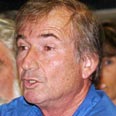
Brig.-Gen. Noy
צילום: אפי שריר
IDF commander: We can’t make buffer zone in Gaza
Equilibrium of fear against Qassam cells like in south Lebanon? Northern Command chief in the 90s explains to Ynet how offensive in Gaza starkly contrasts combat against Hizbullah
The IDF cannot establish a security zone in Gaza as in Lebanon, but only a 2-km (1.2 miles) buffer zone, “whose influence will be minimal,” Brig. Gen. (Res.) Rafi Noy told Ynet. Noy served as Northern Command chief during 1991-1995, while the IDF was deployed in south Lebanon.
On the day the Cabinet decided to intensify the offensive in Gaza, Noy remarked on the difference in the operating styles of Hizbullah versus the Palestinian organizations. “Hizbullah was based on trained cells, while the Palestinians mainly fire Qassams, and isolated cells like the one that kidnapped Gilad Shalit on rare occasions manage to reach the security fence,” Noy said.
“The goal of the security zone that we created in Lebanon was to prevent terror cells from infiltrating and block the non-stop Katyusha fire on northern communities. Hizbullah eventually understood that there was a balance of threats and they couldn’t fire daily towards settlements on the confrontation line, because every time they did, a harsh response followed.”
As an example of retaliatory operation, Noy mentioned Operations “Accountability” and “Grapes of Wrath,” in which the IDF caused hundreds of south Lebanon residents to evacuate their homes and pressure the government to deploy the army in the south to rein in Hizbullah. “The Hizbullah fire was mainly in response to IDF operations, which is in contrast to the current situation in the south, where the Palestinians are initiating the activities and we are responding to them,” Noy said.
According to Noy, the IDF offensive in Gaza is morally justified, but it is important to understand the only once the Palestinian people comprehend the damage the Hamas government is causing them, can the battle be decided. “Hamas doesn’t want to annihilate the state of Israel no matter what its members say in front of the television camera. In their heart of hearts, they understand they have no change, but the thought that such comments strengthen their position on the Palestinian street makes them continue to make such public declarations.”
Another difference Noy points out is the topographical dissimilarity between the two areas. “While the IDF dealt with mountainous and rocky terrain in Lebanon, with valleys and dense vegetation, the area around the security wall in Gaza is fully exposed and all suspicious movement is detected thanks to special technology to identify infiltrators, which didn’t exist in Lebanon, but has been in use for a long time on the Gaza border,” Noy said.
Noy concluded that only a weakening of the Hamas government would aid Israel. “The IDF needs to operate in an efficient manner and understand that this isn’t a two-week affair, or even a two-month affair,” he said. “As long as we upheld our agreement and withdrew to the Gaza border, contrary to in the Hezbollah situation, there is no way to blame us for the current offensive. The world community including the United States and the European Union can’t make any demands to halt the operation, whose main aim is to defend the safety of Israeli civilians.”










